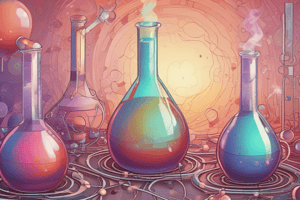Podcast
Questions and Answers
What type of chemical reaction is represented by the equation 2H2 + O2 → 2H2O?
What type of chemical reaction is represented by the equation 2H2 + O2 → 2H2O?
- Synthesis Reaction (correct)
- Decomposition Reaction
- Replacement Reaction
- Combustion Reaction
What is the purpose of adding coefficients in front of the reactants or products in a chemical equation?
What is the purpose of adding coefficients in front of the reactants or products in a chemical equation?
- To indicate the reactants
- To balance the equation (correct)
- To show the reaction rate
- To indicate the products
What is the term for a substance that increases the reaction rate without being consumed by the reaction?
What is the term for a substance that increases the reaction rate without being consumed by the reaction?
- Base
- Acid
- Salt
- Catalyst (correct)
What occurs when an acid reacts with a base in a neutralization reaction?
What occurs when an acid reacts with a base in a neutralization reaction?
What is the effect of increasing the surface area of reactants on the reaction rate?
What is the effect of increasing the surface area of reactants on the reaction rate?
What is a mathematical expression that describes the rate of a chemical reaction?
What is a mathematical expression that describes the rate of a chemical reaction?
Flashcards are hidden until you start studying
Study Notes
Types of Chemical Reactions
- Synthesis Reaction: Two or more substances combine to form a new compound.
- Example: 2H2 + O2 → 2H2O
- Decomposition Reaction: A single compound breaks down into two or more substances.
- Example: 2H2O → 2H2 + O2
- Replacement Reaction: One element replaces another element in a compound.
- Example: Zn + CuSO4 → ZnSO4 + Cu
- Combustion Reaction: A substance reacts with oxygen to produce heat and light.
- Example: 2CH4 + 3O2 → 2CO2 + 3H2O
- Neutralization Reaction: An acid reacts with a base to form a salt and water.
- Example: HCl + NaOH → NaCl + H2O
Chemical Equation
- A chemical equation is a representation of a chemical reaction using chemical formulas and symbols.
- The reactants are written on the left side of the equation, and the products are written on the right side.
- The arrow (→) separates the reactants from the products.
- Chemical equations can be balanced by adding coefficients in front of the reactants or products.
Chemical Reaction Rates
- Factors Affecting Reaction Rate:
- Concentration: Increasing the concentration of reactants increases the reaction rate.
- Temperature: Increasing the temperature increases the reaction rate.
- Surface Area: Increasing the surface area of reactants increases the reaction rate.
- Catalyst: Adding a catalyst can increase the reaction rate.
- Reaction Rate Expression: A mathematical expression that describes the rate of a chemical reaction.
Chemical Reaction Mechanisms
- Elementary Reaction: A single step in a chemical reaction mechanism.
- Reaction Intermediate: A molecule that forms during a chemical reaction but is not a reactant or product.
- Rate-Determining Step: The slowest step in a chemical reaction mechanism, which determines the overall rate of the reaction.
Chemical Reaction Conditions
- Catalyst: A substance that increases the reaction rate without being consumed by the reaction.
- Inhibitor: A substance that decreases the reaction rate.
- Activation Energy: The minimum energy required for a chemical reaction to occur.
- Pressure: Increasing the pressure can increase the reaction rate.
- Light: Certain reactions can be affected by light.
Types of Chemical Reactions
- A synthesis reaction involves two or more substances combining to form a new compound, e.g., 2H2 + O2 → 2H2O.
- A decomposition reaction involves a single compound breaking down into two or more substances, e.g., 2H2O → 2H2 + O2.
- A replacement reaction involves one element replacing another element in a compound, e.g., Zn + CuSO4 → ZnSO4 + Cu.
- A combustion reaction involves a substance reacting with oxygen to produce heat and light, e.g., 2CH4 + 3O2 → 2CO2 + 3H2O.
- A neutralization reaction involves an acid reacting with a base to form a salt and water, e.g., HCl + NaOH → NaCl + H2O.
Chemical Equation
- A chemical equation represents a chemical reaction using chemical formulas and symbols.
- Reactants are written on the left side of the equation, while products are written on the right side.
- The arrow (→) separates the reactants from the products.
- Chemical equations can be balanced by adding coefficients in front of the reactants or products.
Chemical Reaction Rates
- Factors that affect reaction rates include concentration, temperature, surface area, and catalysts.
- Increasing concentration, temperature, and surface area can increase reaction rates.
- Adding a catalyst can also increase the reaction rate.
- The reaction rate expression is a mathematical description of the reaction rate.
Chemical Reaction Mechanisms
- An elementary reaction is a single step in a chemical reaction mechanism.
- A reaction intermediate is a molecule that forms during a chemical reaction but is not a reactant or product.
- The rate-determining step is the slowest step in a chemical reaction mechanism, which determines the overall reaction rate.
Chemical Reaction Conditions
- A catalyst is a substance that increases the reaction rate without being consumed by the reaction.
- An inhibitor is a substance that decreases the reaction rate.
- Activation energy is the minimum energy required for a chemical reaction to occur.
- Increasing pressure and certain wavelengths of light can also impact reaction rates.
Studying That Suits You
Use AI to generate personalized quizzes and flashcards to suit your learning preferences.




